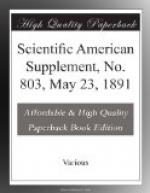England.
Oak bark.
Divi divi.
Myrabolams.
Valonia.
Mimosa.
Extracts { Oak bark and wood hemlock.
Gambier.
Cutch.
Germany and Austria.
Oak bark.
Pine "
Willow bark.
Valonia.
Knoppern.
Myrabolams.
{
Oak bark and wood.
Extracts { Pine bark and wood.
Russia.
Birch bark.
Willow "
Oak "
Pine "
Hemlock extract.
Norway and Sweden.
Birch bark.
Willow "
Oak "
WALTER J. SALOMON.
—Shoe and Leather Reporter.
* * * * *
AN APPARATUS FOR HEATING SUBSTANCES IN GLASS TUBES UNDER PRESSURE.[1]
[Footnote 1: Read at the meeting of the Chemical Section of the Franklin Institute held March 17, 1891.]
By H. PEMBERTON, Jr.
Chemists who do not happen to have in their laboratories oil or air baths for heating closed tubes can make an air bath at short notice from materials furnished by all dealers in steam fittings.
Order:
(1) One four-inch wrought iron pipe, eighteen inches out to out, with usual thread on each end. At about nine inches from either end this pipe is drilled and tapped for a one-inch nipple, in such a manner that a pipe introduced would pass, not on a line with the radius, but about half way between the axis of the four-inch pipe and its walls; in other words, it would be on a line with a chord of the circle.
(2) One one-inch wrought iron nipple, two inches long, one-inch thread on one end.
(3) Two four-inch malleable iron caps, drilled and tapped for a one-inch pipe.
(4) One one-inch wrought iron pipe, twenty-four inches out to out, with a three-inch straight thread on each end.
(5) Two one-inch iron caps. A hole, one-eighth of an inch in diameter, is drilled in the end of one of these caps.
The above order can be given literatim, and will be understood by the dealer, who will furnish, at a trifling cost, the materials, cut and tapped as ordered.
Fig. 1 shows how the whole is put together. The numbers on the figure correspond also to the numbers of the paragraphs of the order as given above.
[Illustration: FIG. 1.]
[Illustration: FIG. 2.]
Fig. 2 is an end section. A cork is inserted in 2 and through it a thermometer, the bulb of which is on a level with the interior pipe. The whole is supported on a few bricks at either end, and is kept steady and in place by a couple of weights or half bricks. It is heated by one or two Bunsen burners, according to the temperature desired.—Jour. Fr. Institute.
* * * * *




